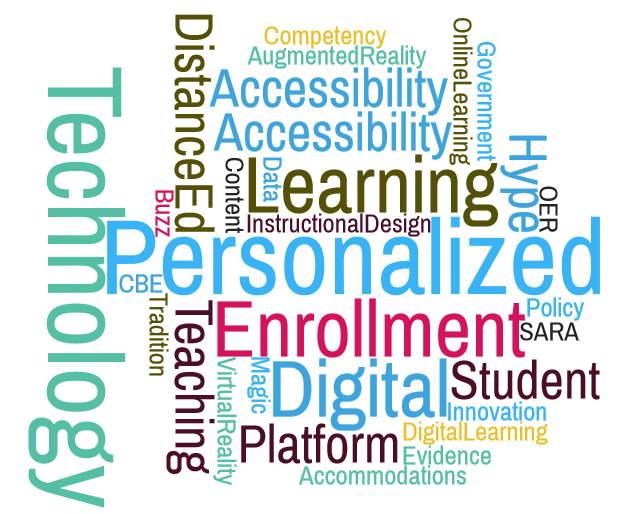It seems like all the cool kids are writing about last year’s trends and predicting what will come to pass in 2018. Well, we WCETers don’t want to be left out of the fun!
Over the last few weeks I’ve discussed 2017 and 2018 with some of the movers and shakers in the higher ed, edtech arena. These conversations provided unique insight into what was interesting and, in some cases, surprising, about 2017, and what we have to look forward to this year.
Thank you to those included in this article for chatting with me for this post. Our conversations were a terrific way to wrap up the year!
What Were the Biggest Surprises in Technology Enhanced Learning in 2017?
2017, was definitely a bit weird news wise, and held some surprises up its sleeves for those of us in higher education.
Virtual and Augmented Reality
Michael Horn, Chief Strategy Officer, Entangled Ventures and Co-Founder and Distinguished Fellow of the Clayton Christensen Institute for Disruptive Innovation …was surprised the hype in higher education around Virtual and Augmented reality, saying that “They will undoubtedly play an exciting role in education, but I’m not yet convinced that they’ll be as easily incorporated with sound instructional design in a widespread way across colleges and universities at a reasonable expense in the near future. The early buzz may prove me wrong, but the verdict is still out.” I for one agree… I’m excited about the possibilities of AR and VR in the classroom. But I feel without a strong focus on good teaching, we’re just using another shiny new technology tool for the sake of using a shiny new technology tool.
Distance Education Growth and Accessibility
Leah Matthews, Executive Director of the Distance Education Accrediting Commission… said she never imagined that by the end of 2017 so many states would have joined SARA (48 so far!). She is thrilled to see a successful higher education grassroots solution to a thorny problem, saying “When I think back to when SARA was gaining its legs, it’s come very far and had very successful results for institutions and students. It’s a real blueprint for how a national effort can be organized.” Leah also addressed distance education enrollment; enrollment in higher education is shrinking steadily, but distance education enrollment is increasing. That tells us a lot about the demand for education in the future.
 Leah and I share continued concerns about digital accessibility, and while she was happy that the distance education community has embraced accessibility as a critical issue for learners, there’s still a lot of work to do in this area.
Leah and I share continued concerns about digital accessibility, and while she was happy that the distance education community has embraced accessibility as a critical issue for learners, there’s still a lot of work to do in this area.
Paid OER Platforms and a Hype-less Year
Phil Hill, Co-Publisher of the e-Literate blog and Partner at MindWires Consulting…knew companies would offer paid platforms for OER at some point, but he was surprised how quickly these products were offered in 2017.
Another surprise, the lack of hype. Phil said, “the market is maturing and moving away from marketing claims of “this will change everything!”” Companies have become more realistic. This could be due to changes in the investment cycle; investors are not investing in every edtech venture and expecting magical returns. Companies are starting to work with institutions and demonstrate that their ideas will actually work.
Government Investments Spur Growth, As Do Small Innovations
Tony Bates, President and CEO of Tony Bates Associates…It would be hard to surprise Tony Bates with anything to do with online learning, but the impact of governmental policy on online enrollment did just that. Each Canadian province governs higher education differently, so Tony and his team can compare/contrast how different distance education impact enrollment. The recent survey (and resulting report) showcased the considerable variance between provinces. For example, the fastest growth rate in distance education occurred in Ontario, where the government has invested heavily in online learning. However, in Quebec, there has not been a government strategy for online learning, and enrollment decreased, at least in the college sector.
Tony was also surprised to learn about the impact of small scale innovations on student success, especially work by faculty that often goes on “under the radar” (on their own, not part of an institutional strategy).
Personalized Learning and CBE
Susan Patrick, President & Chief Executive Officer of the International Association for K-12 Online Learning (iNACOL)…and I discussed several topics, beginning with the 2017 focus on personalized learning and competency based education (CBE). Currently, edtech solutions are built based on traditional models of education and are constrained by subject and the grade-level of the student. Susan has several great ideas on how to improve on the status quo this year….
Personal Devices
 Mike Abbiatti, Executive Director of WCET/Vice President of WICHE... reminded me that there weren’t that many surprises for those who watch the field every day. But, he was intrigued by the interest in the non-technical aspects in of technology enhanced learning: The State Authorization Reciprocity Agreement (SARA), cybersecurity threats, awareness of student needs and accommodations, and an increased focus on personalized learning.
Mike Abbiatti, Executive Director of WCET/Vice President of WICHE... reminded me that there weren’t that many surprises for those who watch the field every day. But, he was intrigued by the interest in the non-technical aspects in of technology enhanced learning: The State Authorization Reciprocity Agreement (SARA), cybersecurity threats, awareness of student needs and accommodations, and an increased focus on personalized learning.
Mike also mentioned that, since technology moves from the home to the institution now, delivery of personalized learning will be through content delivered on personal devices.” Institutions must be ready to address the use of personal devices by its community.
Looking Forward to 2018
Now that we’ve closed out 2017, it’s time to look forward to this year.
2018 Technologies
What technologies could we see a focus on for 2018?
Mobile Learning
 Michael Horn is excited about the developments occurring in the mobile learning space, especially regarding the instructional design processes that take place for mobile learning. Apps like Duolingo paved the way, but more is coming in this space, such as Smartly’s free MBA program, which takes place through their mobile app.
Michael Horn is excited about the developments occurring in the mobile learning space, especially regarding the instructional design processes that take place for mobile learning. Apps like Duolingo paved the way, but more is coming in this space, such as Smartly’s free MBA program, which takes place through their mobile app.
Michael Horn joins us (and other outstanding Higher Ed, EdTech leaders) this week for our “Issues and Trends in EdTech 2018” webinar. There’s still time to register!
Artificial Intelligence and Cybersecurity
Mike Abbiatti felt the focus will be on Virtual and Augmented Reality, which could be controlled by Artificial Intelligence (AI), and adaptive learning. These trends will be in line with personalization trend from 2017. Cyber-defense will be CRITICAL, especially as higher education is a very vulnerable community. We need to increase our education and understanding regarding the risks and benefits of curated, digital content and credentials.
Mike reminded me to consider what people bought at Christmas. Through those gifts and other purchases, we’ve made our homes “AI headquarters.” In 2018, it will no longer be what the institution wants to do technology wise. It will be the institution responding to what their community wants to do with technology.
Comprehensive Student Profiles and Micro-credentials
Susan Patrick ‘s ideas for edtech platforms that could showcase a wholistic profile of students, backed by evidence in some sort of portfolio, would be an excellent direction for vendors in 2018. These student profiles could show student’s broad range of skills and help admissions counselors or employers see readiness for college and careers. The learner profile would have to be a flexible student achievement record that considered competency based education, graduate requirements throughout secondary and postsecondary education, and what kind of edtech could support these models.
Susan and I also discussed badging and micro-credentialing for students and for adults (especially within teacher education,) and how Virtual Reality and Augmented Reality will help us create engaging, complex, real-world problems for students to solve.
Changes in Education
Many of my conversations ended on the topic of changes we may see in education in general.
Vocabulary
In 2018, according to Mike, we will begin to finalize the vocabulary for what higher education delivers. We will define the curated packages of what we deliver and to whom. That will help us move forward to delivering quality, personalized education.
Distance Education Quality
On the distance education front, Leah highlighted the growing reputation of distance education and its ability to meeting the various needs of students. Leah is looking forward to more collaboration across groups that have an interest in distance education, and reminded me that WCET has been a pioneer in this effort through our partnerships with OLC, outreach/support of SARA, etc. She continued, “I’m looking forward to 2018 as a year when there is a real unity around the distance education institutions, regardless of their accreditation, regardless of their state, regardless of their mission.”
Blended Learning Best Practices
Looking forward, Tony Bates would like a standard set of best practices to be developed for faculty for blended learning, and especially guidance on when face-to-face is better pedagogically, based on empirical research. These best practices should be based on good learning theory, easy to understand, and easy for faculty to use and access. Tony’s open book on Teaching in a Digital Age suggests some ideas about how to move this area forward but he acknowledges more research and theory on blended learning is needed.
OER and Quality Teaching
Phil Hill is hoping to see a broader offering of OER and digital content in 2018. Digital content companies and publishers can do more than just offer content, but they can combine OER and digital content, and see companies come up with new models (and not do the same thing as everyone else, but maybe slightly more effectively).
In 2016 and 2017 there was so much talk about efficacy. Phil is also looking forward to the conversation shifting to teaching practices. It’s misguiding to apply efficacy to products alone. Let’s all make 2018 the year where we talk more about quality teaching.
Goodbye 2017

2017 was quite a year, but, to be honest, I’m not that sad to leave it behind.
I closed each of these conversations feeling hopeful and very positive about direction of edtech and education for 2018.
I’m personally looking forward to celebrating the 30th year of WCET, did you know we’re throwing a big birthday bash in Portland this fall?!
Happy New Year and here’s to a great one!
Lindsey

Lindsey Downs
Manager, Communications
WCET – WICHE Cooperative for Educational Technologies
ldowns@wiche.edu @lindsey0427

Photo credit “goodbye” : woodleywonderworks

 Leah and I share continued concerns about digital accessibility, and while she was happy that the distance education community has embraced accessibility as a critical issue for learners, there’s still a lot of work to do in this area.
Leah and I share continued concerns about digital accessibility, and while she was happy that the distance education community has embraced accessibility as a critical issue for learners, there’s still a lot of work to do in this area. Mike Abbiatti, Executive Director of WCET/Vice President of WICHE... reminded me that there weren’t that many surprises for those who watch the field every day. But, he was intrigued by the interest in the non-technical aspects in of technology enhanced learning: The State Authorization Reciprocity Agreement (SARA), cybersecurity threats, awareness of student needs and accommodations, and an increased focus on personalized learning.
Mike Abbiatti, Executive Director of WCET/Vice President of WICHE... reminded me that there weren’t that many surprises for those who watch the field every day. But, he was intrigued by the interest in the non-technical aspects in of technology enhanced learning: The State Authorization Reciprocity Agreement (SARA), cybersecurity threats, awareness of student needs and accommodations, and an increased focus on personalized learning. Michael Horn is excited about the developments occurring in the mobile learning space, especially regarding the instructional design processes that take place for mobile learning. Apps like Duolingo paved the way, but more is coming in this space, such as
Michael Horn is excited about the developments occurring in the mobile learning space, especially regarding the instructional design processes that take place for mobile learning. Apps like Duolingo paved the way, but more is coming in this space, such as 



2 replies on “Looking Back, Looking Forward”
Re: AR & VR: I’ve spent a couple of years thinking about using these technologies in my small splinter of the virtual learning space and have come up with very little. They can make the experience more “immersive” but are difficult to implement across the entire nation’s educational infrastructure. We are at the same place that we were decades ago when the Internet was going to change education. You can see that it has taken those decades to come close to doing so. Despite acceleration of technology, widespread use of AR & VR in education is far in the future right now. For a great many areas of learning, the return is not worth the investment. I am sure this will eventually change.
Re: OER: I have always believed that free OER was (a) not really free, and (b) a problem in the long run due to the necessity of updates as technology advances.
Paid OER makes more sense. Paid educational resources of any sort make the most sense because your payments are an investment in the future of that resource. Without the influx of money, the resource will rapidly become stale and outdated as technology speeds forward.
What’s wrong with paying a very modest amount to support your favorite resources? What is a reasonable amount? Shouldn’t $25 per student for a powerful resource in colleges and universities be acceptable?